We hope you enjoy the articles and short stories presented here, and will join Kate in her adventures for many years to come.
Upon request, you will receive an inscribed copy of Kate Tattersall Adventures in China with every donation of $10 or more plus shipping. Please use the Contact Page to provide your shipping address and we will reply with your total.
Warning: This article contains nudity, depicted through fine art and early photography.
I’ve received several notes asking about various details of the feminine ideal during the Victorian era, and have been apprehensive about writing on this because some of the material is sensitive. Research into much of this subject proves somewhat difficult; in such a staid society very little was recorded. (Perhaps that’s why I’ve had so many queries.) However, there is interesting evidence of certain practices and expectations presented below for interpretation. This encompasses quite a bit including fashion, hygiene, grooming, and body sculpting, and individual articles about each facet would be possible, but I don’t feel they deserve that much attention. I hope this will satisfy those who are curious about such details, and not offend anyone. Keep in mind, many of the fashion and hygiene requirements were generally for the wealthy, and only a portion of women would have taken any to great extremes, or continued them throughout their lifetimes. Due to the large amount of images used in this article the credits are listed at the end. Thousands of examples are available, I selected a small portion to illustrate my findings. Note: When Queen Victoria was crowned, fashion and art were generally only for the upper-classes. As her reign wore on, the middle-classes grew and copied the gentry. By the late 1800s, even the working poor were doing their best to emulate the elite.
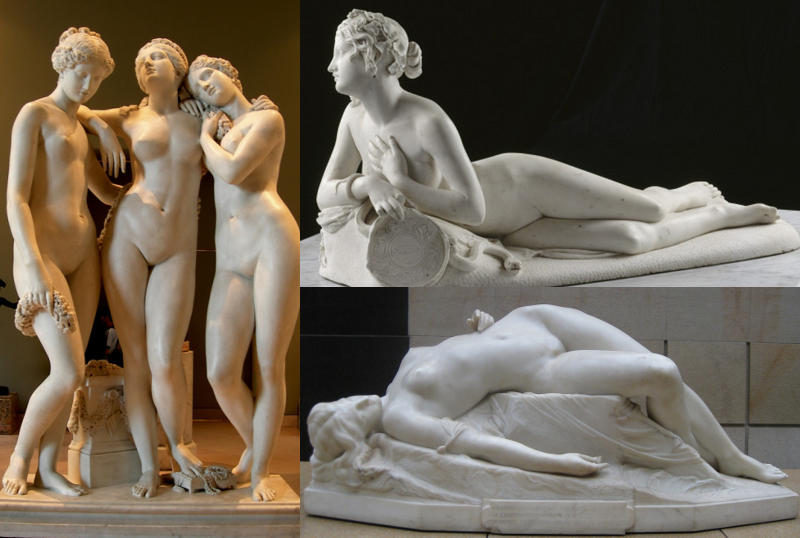
Sculptures from the 1820s to 1870s, imitating the classical style.
Throughout the centuries nude women were usually depicted without any body hair, and the 1800s wasn’t any different. This is a feminine ideal that goes back to the beginning of recorded time. Statues from Victorian times depict women with bare nether regions, and men with pubic hair. The ancient Egyptians customarily removed all body hair, and many shaved their heads; both sexes. This was quite hygienic, reducing the hiding places of parasites and because body hair will trap oils and create odour. In the Greek and Roman bathhouses body hair was stripped off men and women in equal measure. (Perseus is recorded as asking a young man why he took such pains grooming his beard, when he removed the hair from every other part of his body.) The practical cleanliness side of this was desired, but also to emulate the smooth marble statues the artisans were creating. This standard of perfection spread throughout the Roman Empire, and has remained in the psyche of the Western World ever since. Roman and Turkish style bathhouses carried on the tradition century after century. As Dr. Edward Binns observed in 1842, “This practice is very common among Turkish women. Oliver, who travelled by direction of the French Republican Government, speaks of the custom, as does Lady Wortley Montague (we quote both these authors from memory); and the former adds, when they have bathed, dressed, and used the depilatory – for like the North Americans and some other nations, they remove all superfluous hairs from the body – and have fallen asleep, they have perhaps attained the summit of their present desires.” The Anatomy of Sleep or the Art of Procuring Sound & Refreshing Slumber At Will, London 1842. The word depilatory was coined around 1600, as a term for having one’s hair plucked, and evolved into a name for any liquid or cream that is used to remove unwanted hair. Body hair trimming and removal is not new, it is something that has become expected of women but not of men, except some rare circumstances. Enough on background, let’s concentrate on Victorian times, when having a complexion like marble was also desirable (although originally those Greek and Roman statues were painted with flesh tones).
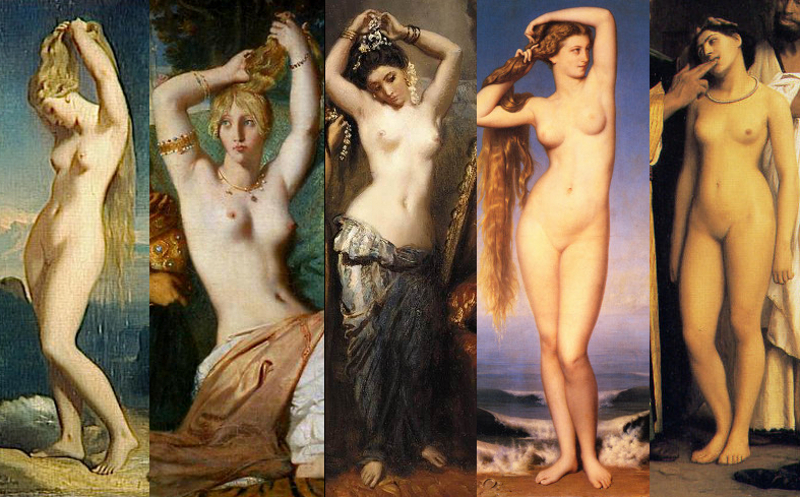
Details of famous and popular nudes from the 1830s to 1860s.
In the 1830s through to the 1860s, artists continued to set a pale hairless clean feminine ideal, representing youth, purity, and virtue. (At the same time there was a “manliness” paragon, arising with the advent of organized sports, world exploration, and military prowess, so beards became popular.) The Victorians believed cleanliness was next to Godliness, and with it came morality and the desire to be respectable; it was preached in the churches and taught at schools. In general, a great deal of the aristocracy weren’t so strict, having made do in their old family homes, making allowances for outdated facilities, and accepting country estate standards with tame moral codes. The nouveau riche industrialists, real estate speculators, bankers, &c., who formed the untitled upper-classes, paid for and expected to live in pristine environments with the finest of everything, some enjoying decadent debauchery, some preferring a sort of stifling religious immaculacy, and others something in between. (One may only speculate at the amount of hypocrisy that went on.) Daily bathing became a luxury demanded by the affluent. Beau Brummell (1778 – 1840) had started a fad of bathing daily as early as 1810, but it wasn’t until the mid 1800s that the practice grew in popularity. A bath might include rubdowns with pumice stones, and applying moisturising oils. They insisted on spotless homes, employed maids who cleaned constantly, and heaven forbid if bedbugs, itch mites, lice, fleas, or ticks ever invaded their sanctuaries. These parasites plagued the poor and were a constant threat to the wealthy as well.
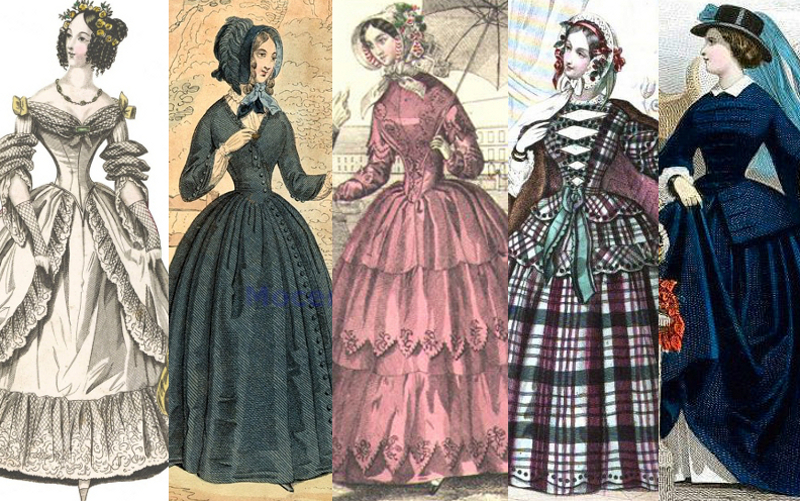
Fashion plates from 1838 to the 1850s. Petticoats and then crinolines were used to achieve bell-shaped skirts. Corsets were quite straight sided. Fashion plates typically exaggerate features; waists were depicted as tiny, as were hands and feet.
Standards in clothing were pushed to extremes by the “ladies of high fashion” in London and Paris. These women were referred to again and again in periodicals and literature, but usually just by that label, no actual names. The Victorian era started with women wearing straight-sided corsets, providing a cone shaped torso, similar to what had been popular during the mid to late 1700’s. Clothes were styled with various types of bulky sleeves (gigot, flared, pagoda, flounced), and voluminous skirts, making waists look small in comparison. The wealthy could afford bright colours in all the various forms of silk fabric, and they must have glowed and sparkled compared to the vast majority of common people. I don’t want to get into too many details about clothing. This is not an article examining all the phases of fashion, but it has to be included to a degree, because women relied on their wardrobes to help create the perfect silhouette of each decade.
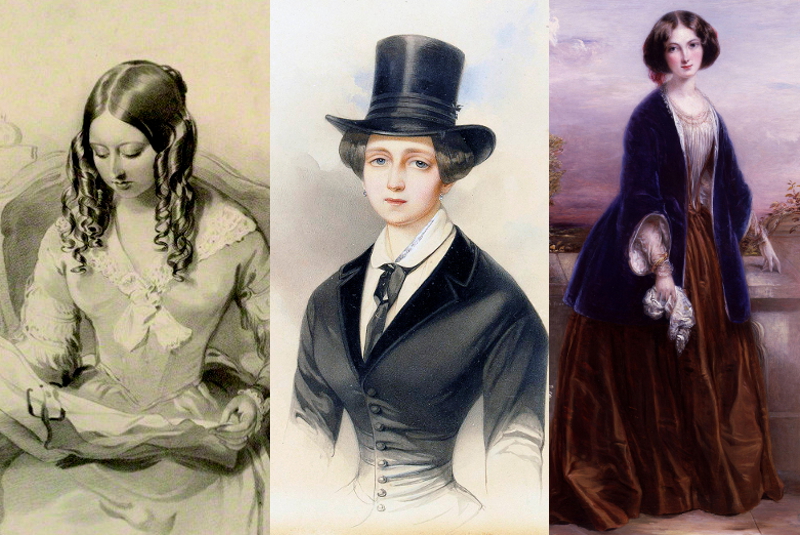
Queen Victoria 1843, Duchess Catherine Mikhailovna 1847, and Effie Gray 1851. Note how their hair is built out at the sides. The drawing of Queen Victoria is probably quite accurate, while the artist may have gone a bit far on Duchess Catherine’s waist, and Effie said her painting made her look like “a graceful doll” so certain features must be exaggerated.
The typical early Victorian era hairstyle was parted down the middle and tied back, often with ringlets or braids at the sides. A woman’s hair was her “crowning glory” and cherished by poor and wealthy alike; only illness would usually force a haircut, but a tiny fraction would be trimmed or singed off monthly to encourage growth and keep the ends healthy. Washing hair was infrequent, due to the harshness of the soaps, so constant brushing cleaned the long tresses and distributed naturally occurring oil, along with the application of other oils and perfumes. Women also put puffs under their hair at the sides to give it more volume. This was to create an illusion that their waists were roughly the same size as their heads. Artists made a point of painting their subjects with these proportions. Women also had hair pieces crafted to be fastened to their heads. In the 1870s curled hair became very popular, because the curling iron was introduced (first patented in 1866) and more elaborate hair styles were expected. Previous to this curling papers or rags would be worn at night (by men too) achieving limited success. Women with straight hair who desired waves or curls could achieve excellent results with this new curling iron invention, but the heat was damaging to their tresses and sometimes burned their hair, so the reasonable alternative consisted of a hairpiece with curls and plaiting, creating the illusion of spending hours on their coiffures. This fad boomed from the late 1860s to about 1875.
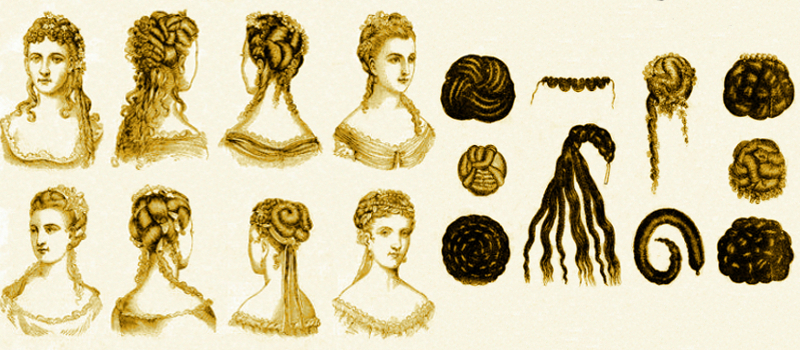
An assortment of Victorian hair pieces made available for sale in catalogues. There were hundreds of styles, and also custom made choices. They were listed as coiffures (complete hairstyles pinned on top) and chignons (buns and rolls pinned at the nape).
Throughout the 1800’s women bleached their hair with various mixtures, the main ingredients included diluted barium, potassium hypochlorite, and lemon juice. Blonde hair was very popular, because it gave young ladies an angelic aura, going nicely with the high moral standards. Brunettes who tried bleaching sometimes ended up with startling shades of red, and dry brittle hair. Dying was achieved to limited degrees using organic compounds like henna, but in 1856 the first synthetic dyes were produced from coal tar. This led to cheaper, stable, enduring, and far more varied colours for fabrics, and long lasting black and brownish options for hair through the 1860s and on. Silver nitrate was utilized to darken hair, and excessive use created a purple shade. It was generally ladies who wanted to hide grey hair who tried the dyes that were available. Bleaching continued with stronger and stronger chemical concoctions. Most of the solutions used for either dying or bleaching were harmful to the scalp, and ingredients included; lead, magnesium, sulphur, iron, glycerine, oxalic acid, &c.
Note: The word shampoo was used throughout the 1800s. It came from India, as a word for massage, from the Hindi champo to knead. It originally meant to wash and massage the body. By the late 1840s it can be found included as a sort of scalp treatment, with a vigorous washing and exfoliating. Scurf was a common word for dead skin and dandruff, which would be washed or combed out, oils shampooed onto the scalp and brushed through the hair. By the late 1860s, shampoo could mean to thoroughly wash with soap and water, and included the hair and scalp, with oils or grease worked in as well, and people would shampoo their teeth with charcoal tooth powder. Hair wash was the term used for what we would consider shampoo today, marketed from the late 1830s onward, to clean hair and remove dandruff. By the late 1800s, the word shampoo had evolved into a hair cleaner and washing process, not a body massage or tooth-brushing.
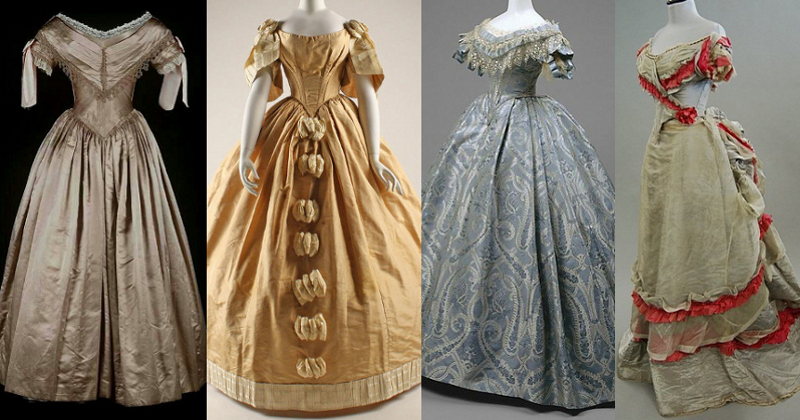
Ball gowns, circa 1840s to the 1870s. The ladies perhaps had bare shoulders and necks, but were otherwise covered up. Arms were often sheathed by mitts (fingerless sheer sleeves) or long gloves.
The most revealing of Victorian women’s clothing was the ball gown, and during the 1840s to 1870s short sleeves covered the armpits, so a lady could dress for a party without worrying about body hair, except perhaps her arms if that was a concern for her. In The Ugly-Girl Papers, chapter XII suggested the use of a paste of ashes or caustic soda for the face and arms, “left on as long as it can be borne, washing with vinegar to take out the alkali, and rubbing on sweet-oil to soften the skin. …the arms, which might be whitened and cleared of hair altogether by bathing them in a hot solution of chloride of lime, as strong as that used for bleaching cotton.” by Harper & Brothers, 1874. Outfits covered most of the flesh, so a woman could have hair everywhere and it wouldn’t be seen. However, women were removing their body hair anyway. Safety razors appeared in the late 1840s (although they weren’t called that until the 1880s) and were very popular, but keep in mind people had to be extremely cautious about cuts as lockjaw (tetanus) killed thousands annually. Woman using razors obviously was a common practice, because Lola Montez (Marie Dolores Eliza Rosanna Gilbert, 1821-61) advised against it as early as the 1850s. She suggested instead: “Spread on a piece of leather equal parts of galbanum* and pitch plaster, and lay it on the culprit hairs as smoothly as possible, and then, after letting it remain for about three minutes, pull it off suddenly, and it will be quite sure to bring out the hairs by the roots, and they will not grow again.” The Arts of Beauty, Lola Montez, 1858.
*Galbanum is an aromatic gum resin, the product of certain Persian plant species.
Judging by the amount of products available during the Victorian era, depilatories might have been the preferred method for women. Sumptuous and expensive bathhouses in cities offered arsenic and quicklime washes which would chemically burn the hair off. Russian steam or vapour baths were available from the early 1800s for those who could afford them, along with other bathing enterprises of various descriptions. Modern Turkish bathhouses (more accurately Irish-Roman) were opened in Britain starting in 1857, and within a decade the craze spread to every urban centre. Over 600 of these spas were established throughout the British Isles.
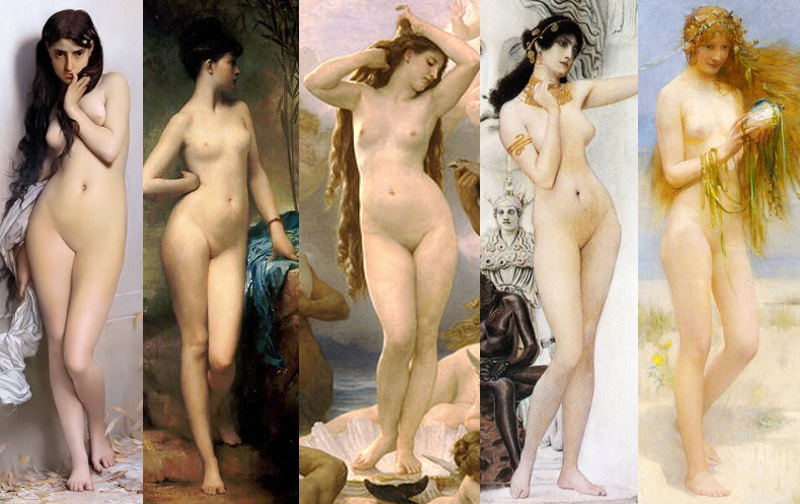
Details of famous and popular nudes from the 1870s to 1890s.
Removing hair with a razor was something anyone could do, along with burning hair off with a candle. Almost every woman had a small pair of sharp sewing scissors that served well for trimming. So, the poor would probably remove hair to cut down on smell between infrequent baths, and to aid in keeping body and pubic lice under control, and to ease inspecting for fleas and ticks. Mothers, sisters, or friends, would help each other and look after removing the eggs of head lice (nit-picking) at the same time. You need only visit a refugee camp or poor village in an economically undeveloped country to witness this going on today. Head lice dwelt throughout Victorian Britain, a report in 1870 estimated 90% of children carried the parasite at any given time.
Meanwhile, wealthy ladies were trying to achieve a goddess-like image, and teaching their daughters to do the same. They did this for hygiene, societal, and personal preference reasons. Most husbands never even saw their wives naked, women were almost always wearing at least a chemise or nightgown with silk hose or stockings. British beaches were segregated, both sexes swimming nude up until the 1840s, when the bathing costume gained popularity amongst women (and men covering up in the late 1850s). Outings to bathhouses made up part of the elite’s calender, so ladies would see their friends and acquaintances naked, although modest women could remain swathed in towels, or avoid such a social function altogether. A hairless body was naturally associated with youth, innocence, and purity, all desirable Victorian qualities, especially for brides and young wives (who were commonly between 16 and 22 years of age). Depilatories were available though various manufacturers, many from France, and advertised that even “the stoutest hairs are transformed into a soft mass which may be removed by water.” Some depilatories were adhesives, applied and then pulled clear, tearing the hair away, and others were chemical, which destroyed the hair. Ingredients included; lime, orpiment (sulphide of arsenic), nitrate, sulphur, quicklime, strong alkaline lye, lard, orris root, liquor of potassa, chalk, starch, pearlash, liver of sulphur, &c. The women were surrounded by fine art depicting the feminine ideal (mostly as imagined by male artists) and some strove to meet such “perfection”. Only the Realist Movement painted body hair on lower-class female subjects, producing unpopular work that was considered vulgar.
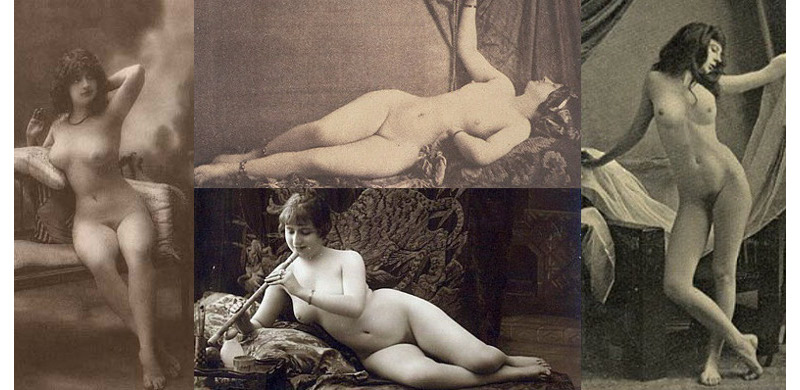
Victorian photos revealing a variety of grooming. The top centre is thought to be the oldest nude image, 1853. The models appear robust. Pundits who claim early nude models were only the poorest of the poor, obviously haven’t witnessed the physiques of true poverty.
Shaved or depilated legs, arms, and armpits, seems to have been the norm for Victorian ladies, perhaps with trimmed nether regions (probably for hygiene purposes), and some bare. Of course, women could think for themselves just as they do today, so personal grooming would have come in all foms. The invention of photography proves this from the 1850s onwards. In each decade women posed for nude photos, and by the 1870s bawdy images started appearing. Whether risqué or lewd, the photographers relied on professional models, actresses, and fallen women, so the work represents a fairly small demographic, but is telling all the same. The range of tasteful to obscene images reveal a variety of grooming preferences. Affluent ladies certainly weren’t the subjects of this new art form. The respectable wife of the Victorian Era became known as the angel in the house, who provided love and comfort, and represented purity and all that was good and gracious. This appellation came from the popular poem The Angel in the House by Coventry Patmore (1823-96). It’s been said that the nobility and upper-class wives were elegant slaves; dressed in the best, bound in the finest taffeta and plushest velvet, forced to be obedient and produce children while maintaining impossible physiques. Of course the very pale complexion was yet another part of this standard. As I touched on in my article about cosmetics, middle-class and affluent ladies stayed out of the sun, and powdered themselves with products like rice dust, zinc oxide, or pearl powder, which was chloride of bismuth usually mixed with French chalk (talc).
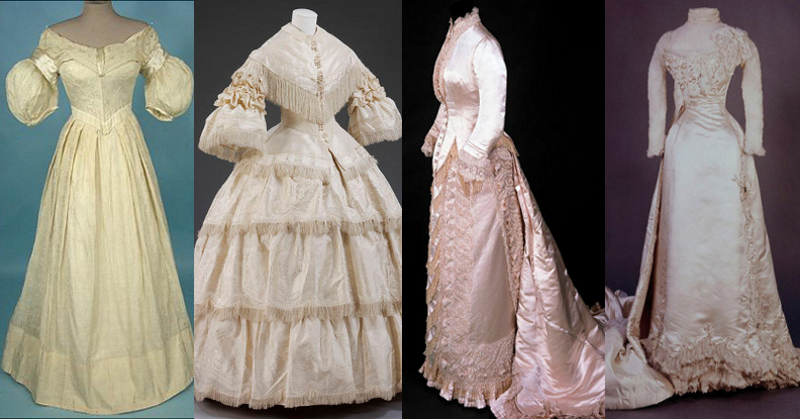
Wedding dresses, from left to right; circa 1840 bust 30 waist 22, 1857 bust 32 waist 25, circa 1880 bust 35 waist 22, and 1898 bust 32 waist 19. Busts were often built up with frills and padding, waists had three or more layers bound tight.
By the late 1850s and on, corsets were providing a decidedly hourglass figure, cinching in the midriff. There are rumours about girls who wanted to be so small that their fiancé’s hands would encircle their waists. How true this is remains dubious, because it would have led to a lot of large grooms with tiny brides. The leading cause of death for women was childbirth, and a great deal of fear accompanied every pregnancy, especially a petite wife carrying her enormous husband’s baby. Folk knowledge and doctors advised that it was wise for couples to be of similar size, although it certainly wasn’t a rule, Queen Victoria (4′ 11″) and Prince Albert (5’10”) providing a good example. Waist sizes of brides were on average commonly 22 inches (56 cms) and as small as 16 inches (40 cm), based on bodices in museums. But remember, these were girls who averaged roughly 5 feet (152 cm) tall, were usually in their teens (so they were still growing), and even though they were affluent, often ate nutritionally poor diets compared to what is available in wealthy countries today. This, of course, would be their measurements with a corset or boned bodice drawing in their waists a couple inches or so, but also girding several layers of fabric. The overall average of waists of young women during the 1800s was probably about 24 inches (61 cm). As women aged and had children, they got bigger, and museums have examples of all sizes. Outer garment sizes are more reliable than undergarments, because there is no way to know how tight a corset may have been tied, while gown bodices were buttoned or closed with hook-and-eye fasteners or, if laced, designed to tie closed neatly at the back, providing a set measurement.
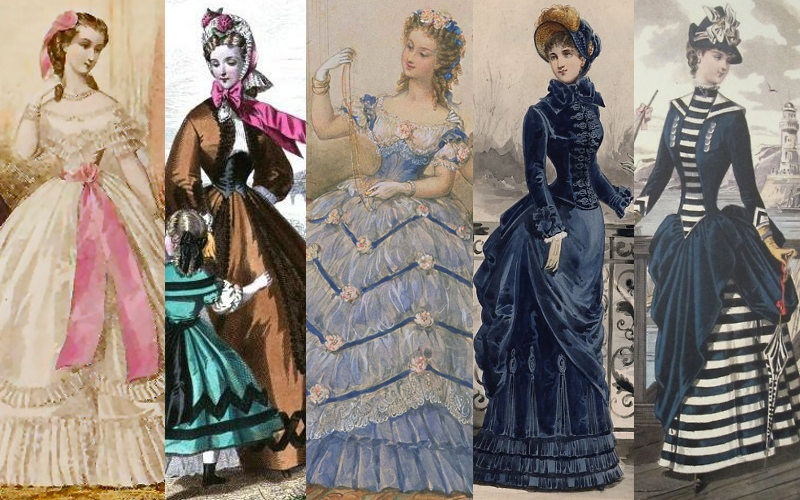
Fashion Plates from the 1860s and 1870s. The corsets provide for more curves. The volume of the skirt shifts from all around to the back. Waists remain remarkably tiny.
From Charlotte Brontë (1816-55) to Charles Dickens (1812-70) to Anthony Trollope (1815-82) to Thomas Hardy (1840-1928), and every other popular and influential Victorian author, they always described their heroines as “pretty” and “nice” young ladies; small, bright, delicate, graceful, modest, polite, caring, quiet, demure, but ready to act decisively in dire circumstances, and with strong moral characters. (At the same time, the heroes were usually tall strong lean gentlemen; honourable, diligent, protective, intelligent, honest, dashing knights in exquisite silk suits, but they were allowed to have forgiveable flaws and dark secrets.) Women of note were described as possessing “noble bosoms” or “figures of consequence” without actually detailing what these euphemisms meant. Examining portraits and fashion plates provides a fairly clear image. Judging from the artwork throughout the Victorian era, an hourglass silhouette was desirable, with a tiny waist and ample bosom and hips, extremes of which were reached with each passing decade. The whale baleen corsets which moulded women into a cone shape were replaced in the 1850s by steel boning, which was less expensive, stronger, more bendable, and increased shaping options. Garments were fashioned to accentuate the silhouette of the corseted torso. Women wore corsets for modesty and sexual allure, so the garment remained popular, in spite of attempts at dress reform. Note: As mentioned in my Early Victorian Undergarments; Part 2 article, it is believed most corsets were worn comfortably, only a portion of ladies tight-laced all the time.
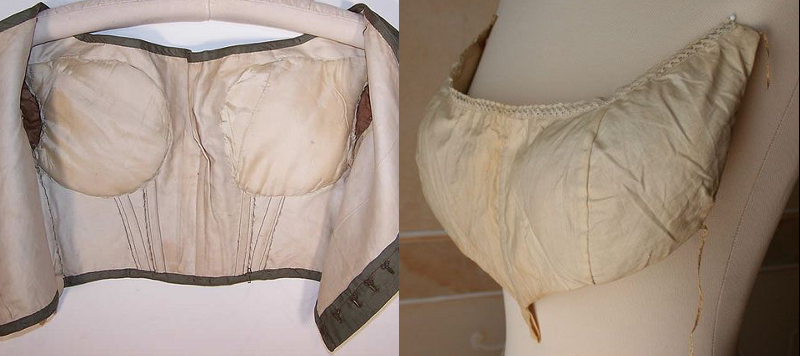
The inside of an 1850s evening gown bodice with built in padding, and a horse hair breast pillow.
Women who accepted the ever tighter-lacing during the 1850s and 1860s, felt it was fine to do so to their daughters in the 1870s and 1880s, so there were a few generations which included some girls brought up trained for very tight corsets, peaking in the late 1890s and into the Edwardian Era. The fad could be compared to Chinese women who bound their feet; girls trained from infancy always had much smaller feet than a girl who started binding at an older age. (Both practices were harmful to the girls, at whatever age.) Tight-lacing wasn’t new, but the number of women using corsets for body sculpting had increased merely because there was a larger middle-class who could afford to indulge themselves, and more garments were available through the booming business of ready-made clothing stores, so even lower-class women could purchase a reinforced corset, instead of wearing relatively soft home-made stays. A tight corset will restrict breathing, and produce the heaving bosom that is often referred to in Victorian and Edwardian accounts, and was considered attractive. Along with the tiny waist came the desire for a noble bosom. Early in the Victorian era bodices were often fashioned with padding built-in to increase bosoms, but it was usually discreet, adding just a bit of volume. By the 1870s and on, a more top-heavy silhouette became popular, leading to breast improvers, which could be worn by women under every article in her wardrobe. Naturally large breasted ladies relied on corsets for support, no other option available until late in the 1800s with the invention of early bra-like undergarments.
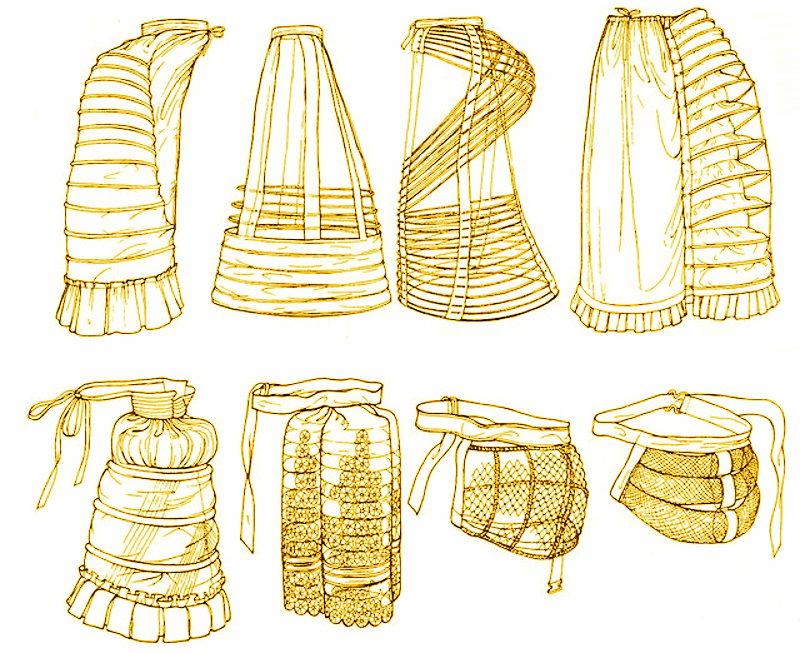
An assortment of late Victorian bustles.
To balance with the ample bosom was the generous hips and, in the late 1800s, the swelling buttocks. Petticoats provided the volume under skirts early on, to be replaced by cage crinolines through the 1850s and 1860s, but then the silhouette shifted to the rear, and bustles became popular. Bustles in the form of little pillows had been used previously, but they didn’t compare to the creations of the 1870s and later, reaching huge proportions in the 1880s. The bulky sleeves of earlier decades had lost popularity, so the illusion of an hourglass silhouette diminished, and as a result waists were drawn in tighter. The first home water heaters were introduced during the 1870s, bathing increased, and more wealthy women could spend hours washing, grooming, and pampering themselves. Then they would dress in their finery, perhaps tight-laced with breast improvers and bustle in place, and go shopping, have tea with friends, or walk in the park, showing off their figures of consequence. So, for the slaves of fashion, slender women added padding, while plump women bound tight.
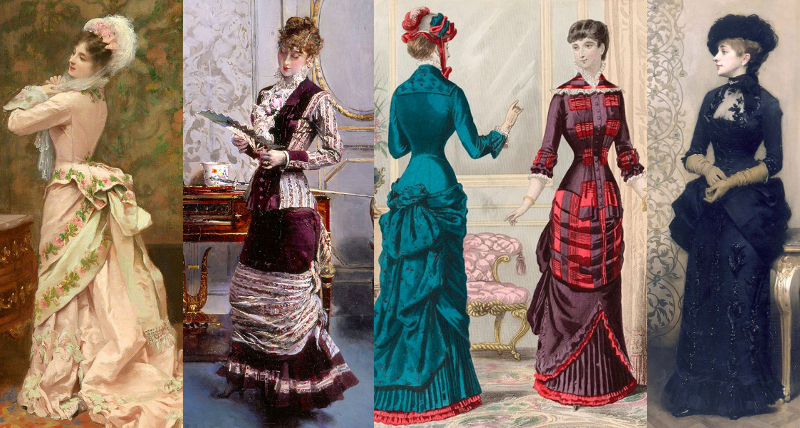
Natural Form Era (1877-83) paintings and a fashion print showing the kind of outfits that were considered “natural” by the Victorians. Note that bustles were worn to a degree during this era.
From about 1877 to 1883 became known as the Natural Form Era, but it was still highlighted by elegant and somewhat restrictive clothing like all the years of Queen Victoria’s reign. Women did not give up their corsets, hair pieces, or cosmetics. This “natural form” period was merely when the bustles virtually disappeared, just to come back in enormous sizes later. Bodices were fashioned long, and smoothed over the hips, helping to create a statuesque torso, but legs appeared short in comparison so shoes and boots were crafted with higher and higher heels. High heels were particularly popular in Paris, spreading to London with the moniker of French shoes/boots. (Custom footwear with 3 to 5 inch heels weren’t uncommon by the late 1880s.) Not all women followed the Natural Form fashion, and examples of stunning beauties with bustles exist from these years. However, the high heels became popular with most young ladies, and corsets inched ever lower, binding and compressing the upper hips as well. The smooth solid firm torso earned the fashion term “cuirass” because the bodices appeared and felt like armour breastplates.
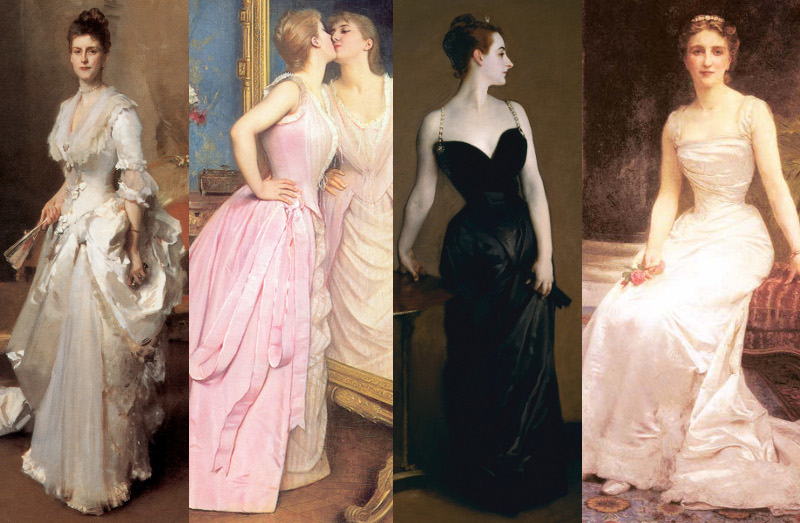
Late Victorian society ladies in their finery. Note the complexions and waists, and the trend towards sleeveless gowns.
All this had been going on while Victorian society was demanding modesty and high moral standards. When Prince Albert died in 1861, Britain went into a sort of prolonged mourning with Queen Victoria, applying a strict moral code. Economic depressions hit Britain in 1866 and 1873-1879, which brought lingering financial woes. Attitudes changed around the end of the 1880s with the phenomenon of the professional beauty and led to the Naughty Nineties, a decade of relative freedom and fun. It started with Queen Victoria’s Golden Jubilee (June 1887) and all the grand official celebrations. Brits decided to cast off the gloom and party, like the French, who were enjoying the peace and gaiety of the Belle Époque (Beautiful Era 1871-1914). Indeed, the French expression joie de vivre, the delight of being alive, entered the English lexicon in the late 1800s. The professional beauty sensation was partly due to the popularity and ever more affordable art of photography, and the work of London-based artist Frank Miles (1852-91) who specialized in pastel portraits of society women. These beauties were fabulously wealthy aristocratic and upper-class “Ladies of Quality” who indulged every whim of fashion and pleasure. Unlike the previous leaders of style, these women were named, and included; Lady Lonsdale (later Lady de Grey), Lady Brooke (later Lady Warwick), the Duchess of Leinster and her sister Lady Helen Vincent, Lady Londonderry, Lady Dalhousie, Lady Ormonde, Lady Mary Mill, Lady Gerard, Madame Pierre Gautreau, née Virginie Avegno, Mrs. Luke Wheeler, and Mrs. Cornwallis West, to name some of the most famous. There was a craze to exhibit photos and prints of these glamour muses in the windows of Fleet Street, making them the original pin-ups. Middle and upper-class Londoners did their best to emulate the lifestyle of carefree partying, and the desire spread to every major city in Britain.
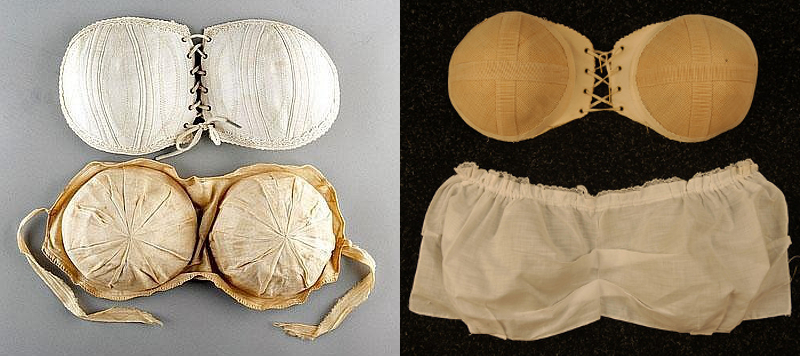
Breast improvers from the 1880s and 1890s.
A society lady possessed mounds of carefully groomed hair, a long neck, a tall and slender build, but with ample bosom, hips, and buttocks, all accentuated by perfectly tailored clothing stretched over a tight-laced corset. As far as the physical aspects go, it was a near to impossible combination only achieved by padding. Blue pencils were used to trace their veins, and powder with blue and lavender tints provided a stark white complexion even in yellow light. They coloured their eyebrows, accentuated their eyes, and reddened their lips, and taught their daughters to do so. As Wentworth Sandys observed of London society in 1889; “The mother and child ‘make such a pretty pair,’ and the not unnatural result is that we have arrived at infantile Professional Beauties, whose photographs are exhibited and sold in the shop windows long before they make their début, and who, by the time they do emerge into society, are as well acquainted with the mysteries of the ‘make-up box’ as any actress on the stage.” The money spent on their wardrobes was astronomical, and paid for by doting fathers, husbands, or admirers. The evening and ball gowns of the late Victorian era featured sleeveless bodices, so removal of armpit hair was expected. These ladies went to dinner parties, court functions, and grand balls bound in their custom undergarments and exquisite gowns, so obviously they could carry out these activities just fine despite the constricting clothing.
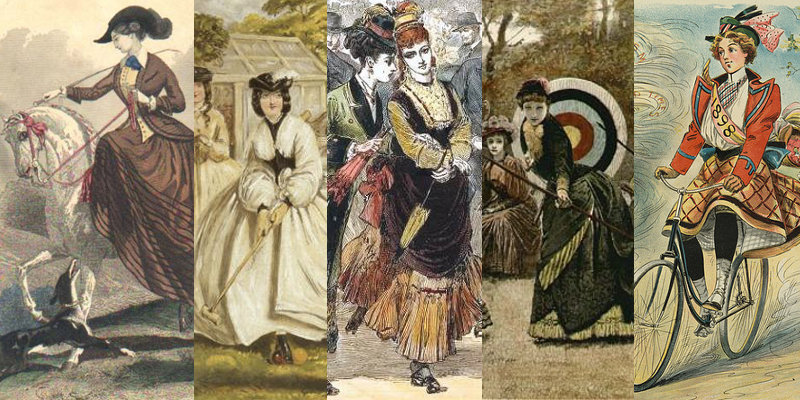
A few Victorian women’s pastimes. Riding in the 1840s, croquet in the 1850s, roller skating in the 1870s, archery in the 1880s, and cycling in the 1890s. Lots of exercise was the key to good health, then as now.
Important to note is that good health and athleticism was encouraged, hopefully resulting in the desirable slender physique, and the fresh air and activity would create an attractive glow. Girls played rounders, football, bowling, and walked two or three hours daily. In the 1850s croquet became the rage, considered an ideal sport for the delicate fairer sex, and enjoyed by all. Equestrian and archery skill were expected amongst the débutantes, and continued into adulthood. Dates between courting couples often consisted of a 10 mile (16 km) hike. Indeed, girls had walking suits made specifically for these occasions, and married women did too; for strolling with their husbands, children, dogs, &c, or merely for exercise and meeting friends. Skating was a favoured winter pastime, and roller skating grew in popularity. By the 1870s gymnasiums started having female members, tennis and croquet clubs were established, and callisthenics were recommended for everyone. In the late 1880s safer bicycles were invented, ladies had cycling suits with breeches made, and began having riding parties. When the Edwardian Era dawned, women getting around by bicycle was commonplace, but still turned a lot of men’s heads.
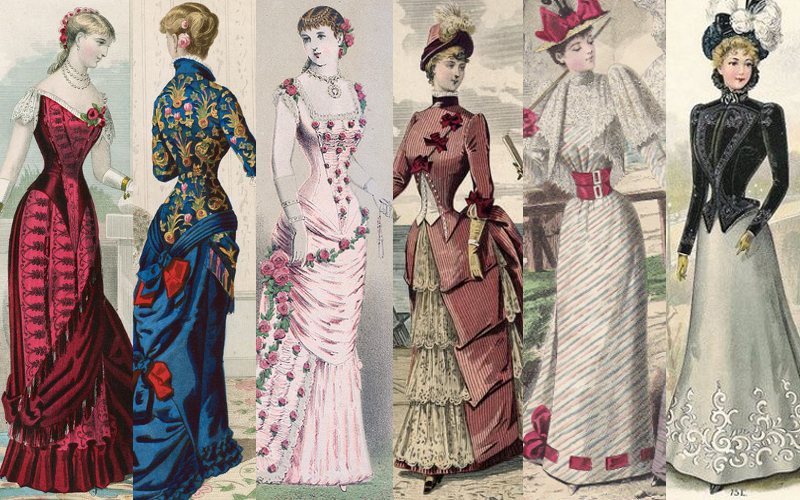
Fashion plates from the 1880s and 1890s. The desired silhouette became top-heavy, the bustle grew then shrank. Puff sleeves in various forms returned. Hands, feet, and waists were still drawn very small.
(After looking at the fashion drawings and artwork presented in this article, I hope people can understand why women wore split-drawers, or nothing at all. If you are interested in cosmetic recipes click here.)
Note: There is no evidence of Victorian women having ribs removed. Surgery was fraught with risk and avoided unless absolutely necessary.
Art credits:
1 (a) The Three Graces 1825, by Jean-Jacques Pradier (1790-1852), Swiss sculptor of the neoclassical style, he worked in France.
1 (b) Bacchante At Rest 1843, by Lorenzo Bartolini (1777-1850), Italian neoclassical sculptor, he was employed by the Buonapartes and Russian royalty.
1 (c) La Jeune Tarentine (Young Tarentine) 1871, by Pierre Alexandre Schoenewerk (1820-85), French sculptor, named a Chevalier of the French Legion of Honour in 1873.
2 (a) Venus Anadyomene (Venus Rising From the Sea) 1838, by Théodore Chasseriau (1819-56), French romantic painter who, despite a young death (37) influenced many fellow artists. He was popular throughout Europe and America.
2 (b) Esther Perparing Herself to Meet King Ahasuerus 1841, by Théodore Chasseriau.
2 (c) Orientalist Interior. Nude in a Harem 1852, by Théodore Chasseriau.
2 (d) La Naissance de Venus (The Birth of Venus) 1862, by Amaury Duval (1808-85), French painter, influenced by the Italian Renaissance art.
2 (e) The Slave Market 1866, by Jean-Léon Gérôme (1824-1904), French painter, sculptor, and teacher, he is considered one of the most important painters from this era of academic art, and had a long list of students. He received honours from many nations, and in 1869 he was elected an honorary member of the British Royal Academy.
4 (a) Queen Victoria 1843, by Magdalena Ross (1801-74), English painter and lithographer who exhibited at the Royal Academy between 1820-56.
4 (b) Duchess Catherine Mikhailovna 1847, by Vladimir Ivanovich Hau (1817
4 (c) Euphemia Gray 1851, by Thomas Richmond (1802-74), British portrait painter, known for his idealised portraits. Although considered a weak artist, he received dozens of commissions and was very popular in London.
7 (a) La Cigale 1871, by Jules Joseph Lefebvre (1836-1911), French painter, educator and theorist. Hugely popular, he won prizes and exhibited dozens of portraits. He taught over 1500 students, many from Britain and the United States.
7 (b) Chloé 1875, by Jules Joseph Lefebvre (1836-1911).
7 (c) Birth of Venus 1879, by Adolphe-William Bouguereau (1825-1905), French academic painter and traditionalist who was popular throughout Europe and the United States. He received many official honours, and garnered top prices for his work.
7 (d) Allegory of Sculpture 1889, by Gustav Klimt (1862-1918), Austrian painter noted for his murals, his primary subject was the female body. He received some prizes during his life, but his posthumous success is astounding. His paintings have brought some of the highest prices recorded for individual works of art.
7 (e) The Sea Maid 1897, by Arthur Hacker (1858-1919), English classicist painter, he was twice exhibited at the Royal Academy, in 1878 and 1910, and was elected an Academician in 1910.
13 (a) Toilette 1877, by Jules James Rougeron (1841-80), French artist best known for his portraits.
13 (b) Berthè che Guarda un Ventaglio (Berthè Reading a Fan) 1878, by Giovanni Boldini (1842-1931), Italian painter who gained success doing portraits of premier members of society in London. He also became the most fashionable portrait painter in Paris.
13 (d) La Parisienne (The Parisian) 1883, by Charles-Alexandre Giron (1850-1914), Swiss painter known for his portraits and landscapes, he moved from capital to capital and was a very respected painter amongst the international upper class because of his elegant style.
14 (a) Mrs Henry White 1883, by John Singer Sargent (1856-1925), American artist who trained in Paris and London, he is considered the leading portrait painter of his generation. He was hugely popular, sometimes controversial, and received many important commissions.
14 (b) Vanity 1890, by Auguste Toulmouche (1829-90), French painter known for his portraits of pretty ladies, he was named a Chevalier of the Legion of Honour.
14 (c) Madame X (Madame Pierre Gautreau, née Virginie Avegno) 1884, by John Singer Sargent.
14 (d) Portrait of Madame Olry-Roederer 1900, by Adolphe-William Bouguereau.
Most of these images were selected from Wikipedia, where you can read more about each artist and view some of their work.
We hope you enjoy the articles and short stories presented here, and will join Kate in her adventures for many years to come.
Upon request, you will receive an inscribed copy of Kate Tattersall Adventures in China with every donation of $10 or more plus shipping. Please use the Contact Page to provide your shipping address and we will reply with your total.

Wow! Thanks for this. It’s amazing how much of this applies to now. You’ve practically outlined an anthropology/sociology thesis here.
I read modern articles and debates about women and shaving, but I never thought about it as a hygiene and parasite thing. We forget how much we’ve changed in regards to washing and stuff. This really changes my perspective.
Hi there! I genuinely enjoy reading your blog posts about Victorian times.
This was so cool to learn about. I just wanted to ask if you know what Victorian Women wore when pregnant?
@ Zayna, wealthy ladies had garments tailored to fit perfectly as they went through the stages of pregnancy, including custom corsets. Of course the practice of tight-lacing couldn’t be maintained. Women who didn’t allow weight gain and continued to tight-lace would suffer miscarriages.
Hotties! Those women knew how to dress. I’m jealous!
beautiful and sexy
I’m so happy to be a size 5 in a shoe. I’m 5’7 and wear a size 2 in a dress. My husband told me it’s because of my aristocratic blood.
Wow absolutely amazing, I bound my waist in the mid 1970’s under my high school uniform for 6 months and still at age 54 have a waspish waist. Girls of 10 were tightly bound with silk bandages, I used crepe back then.
Your website is absolutely fantastic! I am really fond of reading stuff about the Regency and the Victorian Era and after browsing through websites, I found these colorful women’s fashion plates. I am so thankful that you created this website I’ve had so much fun discussing the fashions with my beau!
This website is really more than fantastic! Congratulations
Thank you so much for your posts~ This website is already on my bookmark list.
Reading your articles makes me feel like I am on a time machine.
I love the look of this blog. Excellent work!
I’m a curvy size 12 and do not care if people say I am big. I have full bust, naturally tapered waist, and rounded flaring hips. 40′ bust, 28′ waist, 43′ hips and proud.
I love the Victorian fashion. I would wear those kinds of dresses today if I knew where I could get some, although I wouldn’t be able to wear them to school (school uniform). It is cool that Effie Gray was in here. I look almost exactly like her sister Sophy, but I am 13 and Sophy is 14 in the famous picture of her. Anyway, I really liked this website – it was really informative and I liked the images you put in.
Thanks Christina. Maybe you will be an historical interpreter/re-enactor someday. Make sure you eat healthy, not like Sophy.
Very useful for EPQ
I love these times. I was born in the WRONG era .
Amazing and detailed research! Is there an article on facial beauty, makeup and hair in more detail? I’m really interested in the facial part of beauty standards.
Hi Kate. There are two articles about makeup: http://www.katetattersall.com/early-victorian-era-make-up/ http://www.katetattersall.com/victorian-cosmetic-recipes-powders-lip-salves-creams-other-make-up-of-the-1800s/
This is very well done! I can tell how much research and work was put into this article, and it’s absolutely worth it! I love the Victorian Era and it’s fashion, and I wish more people would realize how beautiful and interesting things were back then.
Thanks Bennie.
Really interesting and well documented. I always wondered what Victorian women hid under all those layers of clothing – obviously shaving or depilating was a plus, since in Summertime it must have been pretty warm and damp in there… There is a story about Effie Gray – true or false – that when she undressed in front of Ruskin, her first husband, on their wedding night, he was so shocked by her displaying pubic hair he decided not to touch her, which of course would have led to her requesting later an annulment of the marriage by non-consummation for impotence. The idea was that, used to naked hairless women on Orientalist paintings and mythological themes, Ruskin was frightened by Effie’s pubic bush. I always doubted it – Ruskin, like most males of his time, would have had sexual experiences in brothels and experienced firsthand what a grown woman’s genitalia, bald or hairy, would have been like. If, however, the story was true, Effie would have been seen as a vulgar and unpleasant woman if she had not had her pubic hair removed, and he would have had good reason not to touch her, since she was not up to the standards expected of a young wife and potential mother of the affluent middle class.
This is the best informative blog I’ve ever seen.
I absolutely love how informative this post was! The lovely paintings and pictures are ingrained in my memory now haha.